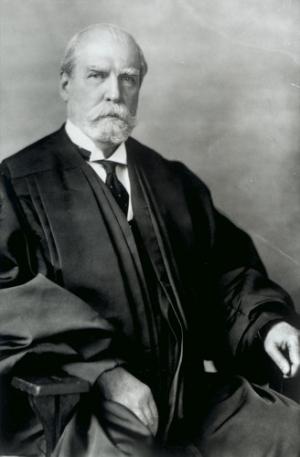 SKC Films Library SKC Films Library |
|
|
| SKC Films Library >> American History >> United States: General History and Description >> Late 19th Century, 1865-1900 >> Biography, A-Z |
 Charles Evans Hughes Charles Evans HughesSupreme Court Justice, Secretary of State Charles Evans Hughes was born in Glen Falls, New York, on April 11, 1862, the son of David Charles and Mary Catherine (Connelly) Hughes. His parents moved to New York City soon after his birth, and he grew up there. Educated primarily by his parents, Hughes learned to read at the age of three and a half and by age six was reading and reciting verses from the New Testament, doing mental arithmetic, and studying French and German. He completed his basic education at Madison College (now Colgate University) in 1878, and graduated from Brown University in 1881. After a brief stint as a teacher, Hughes entered Columbia Law School, from which he graduated first in his class in 1884. He then passed his bar exam with an unprecedented score of 99-1/2 percent, after which he spent 20 years with Chamberlain, Carter, and Hornblower, a prominent New York City law firm. In 1885, Hughes met Antoinette Carter, the daughter of a senior partner of the law firm where he worked; they were married in 1888. Hughes first gained national prominence in 1905 as counsel to two New York state legislative committees investigating abuses in the gas and electric power industries and the life insurance business (the Stevens Gas Commission and Armstrong Commission, respectively). In 1906, Hughes ran for Governor of New York. Thanks in part to an endorsement from President Theodore Roosevelt, Hughes defeated newspaper publisher William Randolph Hearst, and was the only Republican to win a statewide office in New York that year. He was re-elected in 1908, but only narrowly. During his tenure as Governor, Hughes oversaw improvement of the machinery and processes of government, extension of the state's regulatory authority over businesses engaged in public services, and expansion of governmental police and welfare functions. On April 25, 1910, Hughes was appointed by President William Howard Taft to the Associate Justice of the United States Supreme Court seat vacated by David J. Brewer. He was confirmed by the Senate on May 2, 1910, and was sworn in on October 10. He wrote two majority decisions during his tenure -- Bailey v. Alabama (1911), which held that involuntary servitude encompassed more than just slavery, and Interstate Commerce Comm. v. Atchison T & SF R Co. (1914), ruling that the Interstate Commerce Commission could regulate intrastate rates if they were significantly intertwined with interstate commerce. He and Oliver Wendell Holmes, Jr. were the dissenting votes in the case of Frank v. Mangum (1915), in which the Court upheld the decision of lower courts to sustain the guilty verdict (for murder) against Leo Frank. Hughes resigned from the Supreme Court in 1916 to run against President Woodrow Wilson as the nominee of the Republican Party, with endorsement from the Progressive Party. The election ended up being very close, with California being the deciding state. By the time the count was completed, Wilson won re-election by 23 electoral and 594,188 popular votes. Following the election, Hughes returned to his law practice in New York City. Hughes returned to public office in 1921, when he became Secretary of State under President Warren Harding. He stayed on that position after Calvin Coolidge assumed the presidency (upon Harding's death), but stepped down after Coolidge began his full term in 1925. During his tenure at State, Hughes negotiated a separate peace treaty with Germany when the Senate failed to ratify the Treaty of Versailles, chaired the Washington Disarmament Conference in 1921-1922, supported U.S. participation in the World Court, and withheld American recognition of the Soviet Union. He also increased U.S. prestige in Latin America by arbitrating disputes between countries in the Western Hemisphere, seeing to it that the United States recognized the new government in Mexico, and supported the compensation of Colombia for the 1903 Panamanian revolt, which the United States had supported. To improve morale and increase the level of talent in the State Department, he actively supported the 1924 Foreign Service Act (Rogers Act), which eventually resulted in a professional, highly-trained Foreign Service. Upon leaving the State Department, Hughes once again returned to his law practice. He did not leave public service entirely, however, heading a commission to reform New York state government (1926) and serving on both the Permanent Court of Arbitration (1926-30) and the Permanent Court of International Justice (1928-30)., while also arguing over 50 cases before the Supreme Court. In 1930, President Herbert Hoover nominated Hughes to replace the just-deceased William Howard Taft as Chief Justice of the Supreme Court. Despite some opposition in the Senate, Hughes was confirmed, and was sworn in on February 24. During his tenure as Chief Justice, Hughes authored twice as many opinions as any other member of his Court. Many of those opinions concerned New Deal legislation crafted by President Franklin D. Roosevelt, much of which was ruled unconstitutional. Hughes also successfully opposed Roosevelt's plan to pack the Supreme Court in 1937. Charles Evans Hughes retired from the Supreme Court, and public life in general, on June 30, 1941. He died in Osterville, Massachusetts, on August 27, 1948. WEB SOURCES SEE ALSO |
| SKC Films Library >> American History >> United States: General History and Description >> Late 19th Century, 1865-1900 >> Biography, A-Z This page was last updated on April 11, 2017. |